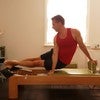Description
About This Video
Transcript
Read Full Transcript
Hi, my name is Dana Santi. And today we are going to talk about the positions of the feeds parallel versus turnout. And I think it's easiest to dissect in a way that the muscles and the way that the foot is going to work or how I'm going to ask it to work. And I think from there as practitioners and teachers, everyone can kind of make a better decision and understand which position may or may not be better for our clients or for ourselves. And that could change daily.
So I'm going to work with Colleen and the first thing we're going to go through is the very first foot work. So what I'm gonna have you do is lie down and I'm going to start with her parallel because it's a lot easier to understand, uh, in that position than it is with it rotated out. So let's go through it. I have her on three springs and I'm going to start there to see, we may have to drop it, um, which is surprising, but that's the case when, when we get this footwork going. So I have her a little separated here and a lot of times I'll do stuff separated so I can myself see which side is dominant, right? Or which is not dominant. We don't, we don't know, right?
When we shove our legs so close together sometimes, um, and the dominant one will always help the weaker. So from here she's got all of her toes on the bar and I want the ball of the foot. The padding is actually what's going to press into the bar, but it's not just pressing in, it's pressing in and down to keep it stable. So it's not literally an in and down, right. What I don't want is for your skin, right?
To feel like it's sliding up. So she's going to press in and I almost want you to think almost like a diagonal dagger, right? That's coming down towards the front of the bar here. So take this and now press in and down as you go to press out and now bend the knees and just come right back in and do that again. Press in and down and come back and press in, in, down, and come back. Now we have to talk a little bit about the heel because that's the other half of your foot. We can't do 100% the work and the top of the foot.
That wouldn't be correct, right? It's gotta be a 50 50 type of thing. So with your heels, if you take your heels on the foot bar,
And now just press in and a little yes up and then come back in and again and then come back up and go in and up again and then come back. Do you feel that? So now I'm going to ask you to go back to your toes in that first foot work and both parts of the foot, even though she's only pressing with the ball of the foot, the heel still has to not move, but it has to press in the air, right? Press in and up as you go out. Okay, so the front part of the foot is pressing in and down. The bottom part is pressing in and up. Ready and press there and then bend the knees and control it in and again.
[inaudible]. Now do one more. Press it away and bring it in. Yes. Okay. Now last component is I'm going to ask her to literally take her big toe. Okay. That's the hardest one and that last little joint. Okay. On that nail bed, I kind of want her to try to soften. I don't want it to be locked. It can be in any position we put it in, but the joint itself somewhat has to unlock. Okay.
Don't put a lot of brain effort into it because it, it will, it will come. But I don't want the toes to stick up in that joint to lock. So now press
And bring it back in and again. And now that ankles don't move, the feet don't move. Now take your heels and press them in and up. And do that one more time. Press now. Stay there. Now take the heels, get them in and up and stay there.
Stay out there. Press the heels in and up. And the ball of the foot in and down there. So now her knee can't possibly lock, right, because both sides of the foot are working equally. Ah, come back in. Ready? Do One more press. Now give me your heel a little bit more. The one that's in the air is always the one that's hard to get at. There you go. And then soften the big toe little and then come back in.
So go ahead and impress out one more time. So the top of the foot in, in down the bottom of the foot in an up and then bend your knees and bring it right back in. And do you feel anything different? Yes. So I think what happens is we don't really know where they're going to feel it exactly right. It's not my job to know where the muscle that's going to be weak, strong, tight, right?
My job is to get her body in the best anatomical shape that I can get it in. And where I thought maybe she was gonna feel it was not where it, where she needed it today. Right? This is corrective exercise that supposed to correct imbalances, weaknesses, you know, we could, we could go on for days with that, but going back to the feed and understanding how they work, then we make our better decision on whether to go parallel or rotate out. I have a lot of tight men. And the last thing I'm gonna do is rotate them out because they're going to take this and they're going to start to squeeze it and do all that stuff that we were taught to do. And it's, this is not the day to talk about it, but that's gonna tighten them more into there, their back, that low back and I want to take them and I want to open them and I want to open that back.
So nine times out of 10 we're going to bring here, bring that guy here in parallel, right? And I don't have to, I don't have to figure out where he's going to feel it. I just have to make sure he's working as efficiently as he can right through these positions. So taking this now, understanding what the feet need to do, I'm going to turn her out here and now it's the same thing. So we're going to take, even though we're not on that flat surface, we're going to try to take the top of the foot and bring it over the bar. We're going to try to take the bottom of the foot and bring it under the bar. Tee The ball.
The foot is still going to press in and where now, so it's almost in think of going in and then towards the middle of the foot and the heel is going to go in and towards the middle of the foot. All right. And now press it away. Now stay there. Try to take the, he'll work it in and up. Take the ball of the foot. There you go. Take the toes and try to wrap them around. And now bend the knee.
Bring it right back in. Okay, so now see the shape that you're in here. We're gonna do our best to just keep it there. So get your foot in the muscles in it to work where we want them to right now. And now go ahead and press away. Hold on to that. And now bend the knees and come back in.
And I'll put a tiny bit, she's rotating a little bit inward, so just don't think so hard. Put an little extra brain power right towards that third and fourth toe. Okay. And
And one more time
So I'm going to start parallel and I'm not going to let her legs touch just so we can see the imbalances better and she can see the imbalances better. So now I want you to lift up, so we're still gonna press with the ball of the foot, okay. And where it is still going to go in and down and the heels still gonna work in and up. Okay. I'm going to have her take her obliques and run them wide. Okay. This way, so you're trying to take, it's almost like you're trying to take them and kind of pull the skin right away from the thighs. From here.
Press it away.
So press into my fingers more there. You feel that? Now again, she can't lock that joint. It's impossible, right? Bend the knees, come back in and again, press it away. Good girl. And then bend the knees and bring it back in. Keep into me here. There you go.
And now press soften the big toe. Just subtle, just subtle. Bend the knee, bring it back in and press it away. Keep the energy in both sides of the foot, the top and the bottom, and then bend the knees. Keep it, keep it and bring it back in. Yes. Okay. So I started her parallel because I started her foot work parallel and it's a lot easier again to understand as a client or as a practitioner what your foot has to do as opposed to asking it to do all of that and then turn it out into a different position. And again, this is, this parallel position is going to be a little better on the guy, right. With the tight back so he can open, right.
I can't trust him yet to understand if I turn his legs out right, he's not going to go right into his low back again. Okay. So from here, with that being said, you've got to find back, rotate out. So now the same thing that we did lift the heels. So now you're going to press in and down and get the heels to go in and up and then bend the knees and bring it back in and again and it away. Soften the toe joint a little and then bend the knees and bring it back in.
And just like your foot work, put a little bit of brainpower towards the outside of your foot so it stays a little more stable at a girl. And then bend the knees and bring it back in and one more time and press it away and bend the knees and bring it back in. Yes, and I didn't lower and lift her heels because that's another component, right? That I'm going to ask the heel to work that same direction going under the bar and coming right back up. So that's a little bit more of an advanced notion as well as I do believe this turned out foot is a little bit more of an advanced notion when you can get the feeling right of whatever it is you're supposed to feel, these will all you have choices. Okay. All right.
Step off and let's do swan. On the barrel. So now we're at the barrel and we're going to take the same foot components that we did on the reformer and now we're going to lie her on her stomach. So she's going to be the opposite direction, but still have to be working the foot in the same direction that we did right when she was upright. So let's start with parallel because we've been starting with parallel each time, and I'm going to have her place her feet low like this to start with. And I'm going to take your hips, go ahead, bring them all the way forward and then your arms down and they start just like we would a regular swan.
But now here's where her feet are and I want her to take the ball of the foot and press it in. Now she goes in and up and the heel is going to go in and down. So she really tries to reach all the wrinkles out of the back of this Achilles there. And low and behold, her foot looks like it may be resting over a foot corrector. Okay. Take the arms now, pull the belly button a little bit towards the tailbone and get those feet to go where they need to go. And from there, go ahead. Length in the neck a little bit. There you go. And lift this, lift your torso up and now go ahead and lift and go back.
But lift and go back. Press into the heels, a little more presence of the ball of the foot there. So are joints on lock again and then pull the belly button, keep it kind of away from the barrel. And now don't round, just lengthen over the barrel and come home and try that again. Get your feet all situated, they're working and lengthen and she goes up and now do a brain check and just kind of check the feet. Are they working there? She goes a little bit more when she gets into them and then pull the belly button away from the barrel and just lengthened over it and come home and just do one more calling and going up and do a little brain check. What's working, what's not working and bring it back and then come back home. Lengthen.
Yes. Okay. Now the position that we all know right where you put your feet on up and she's gonna rotate out. But again, we're going to try to get, and we're going to replicate what we did on that foot bar somewhat. So from here I'm going to have her go towards the middle of her foot. Okay, there you go. Cause she had to use a little bit of brain power on foot work to get towards that third and fourth toe. So I'm going to mimic that here.
And now the toes are going to try to wrap under as the pinkies wrap over. But now the ball of the foot is pressing into the bar and up and the heels are pressing into my fingers here and down that way towards her arch. Okay, so keep this position and take the knees. Let's see. Go a little tiny bit wider with your right leg.
A little. There you go. Okay, let's give it a whirl and see what happens. So put your brain to your feet. That a girl. See they kind of go out a little bit more on their own. And now lengthen your neck a bit there and start to come up with the torso. Okay, now from here, press in and up in the ball of the foot and in and down in your heel. Lengthen more. [inaudible].
Now what if you take your old bleaks and pull the old Blake's really wide. There you go. You've got a little more space for your pelvis to work. And then pull the belly button to the tailbone and come back home. And one more time going on up and reach it back. That a girl. So now here's the barrel in front of you.
And here's your spine. So this has to come down first, get to the low stomach, and then the middle, and then the upper yes. And then go ahead and step down and roll yourself up. Now try to keep the weight even on your feet, right? So the heel and the ball of the foot.
Comments
1. Would you omit turned out feet positioning completely for people whose hips are rotated out when walking?
2. How do you address different leg length in footwork? (It's a totally different topic I believe)
Thanks
You need to be a subscriber to post a comment.
Please Log In or Create an Account to start your free trial.


















